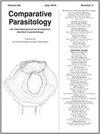First Report of Zoonotic Tapeworms, Dibothriocephalus latus (Linnaeus, 1758) and D. dendriticus (Nitzsch, 1824), and Other Endohelminth Parasites in Chinook Salmon, Oncorhynchus tshawytscha, in Chile
IF 0.4
4区 医学
Q4 PARASITOLOGY
引用次数: 0
Abstract
ABSTRACT: In the present study, the zoonotic tapeworms Dibothriocephalus latus and Dibothriocephalus dendriticus were identified for the first time, using morphological and molecular procedures, in a population of introduced Chinook salmon in Chile. The morphological differences observed between plerocercoids of D. latus and D. dendriticus were, respectively, a retracted and obscured scolex versus one that is always visible and only partially retracted after cold fixation; extension of frontal glands; size, types of, density of, and distribution of microtriches; and number of parenchymal longitudinal muscle bundles within 50-µm spaces. With scanning electronic microscopy, both species presented 3 types of microtriches: coniform and uncinated spinitriches, and capilliform filitriches. In the body region, D. latus presents all types of microtriches, but D. dendriticus only possessed capilliform filitriches. Multiplex PCR targeting cox1 of Diphyllobothriidae and subsequent sequence analysis allowed for confirmation of species identity. All adult Chinook salmon examined (32–60 cm total length) were infected by Dibothriocephalus spp. with a range of 15–192 plerocercoids. Plerocercoids were found in the stomach, intestine, liver, spleen, gonads, swim bladder, peritoneum, heart, and muscles. The prevalence of infected salmon, the percentage of plerocercoids, and the mean intensity of D. latus in the muscles were 3, 4, and 2 times greater than that of D. dendriticus. Histological examination of the stomach, liver, spleen, gonads, and muscle revealed the presence of 1 or more encysted or free plerocercoids. In most cases, varying degrees of chronic inflammation and low presence of neutrophils were observed. The prey consumed by Chinook salmon included the native fish, Galaxias maculatus, and unidentified fish and amphipods. Other identified endohelminths were Derogenes lacustris Tsuchida, Flores, Viozzi, Rauque, and Urabe, 2021 in the stomach, Camallanus corderoi Torres, Teuber and Miranda, 1990 in the intestine, larvae of Contracaecum sp. in the intestinal wall, and Acanthocephalus tumescens (von Linstow, 1896) in the intestine. All identified parasites are reported for the first time in Chinook salmon from Chile.摘要:本研究采用形态学和分子生物学方法,首次在智利引进的奇努克鲑鱼种群中鉴定出人畜共患绦虫Dibothriocephalus latus和Dibothreocephalus dendrictus。在D.latus和D.dendrictus的plerocercoid之间观察到的形态差异分别是,头节缩回和模糊,而头节在冷固定后始终可见且仅部分缩回;额腺延伸;微富的大小、类型、密度和分布;以及50µm间隙内的实质纵向肌束的数量。在扫描电子显微镜下,这两个物种都呈现出3种类型的微丝:针叶树和未带齿的刺,以及capilliformfilitriches。在身体区域,D.latus呈现出各种类型的微毛,但D.dendrictus只具有毛细管状的丝状体。多重聚合酶链式反应靶向白喉杆菌科的cox1,随后进行序列分析,以确认物种身份。检查的所有成年奇努克鲑鱼(全长32-60厘米)都感染了Dibothriocephalus spp.,感染范围为15-192个多头类。在胃、肠、肝、脾、性腺、膀胱、腹膜、心脏和肌肉中发现了类囊体。受感染的三文鱼的患病率、类脂蛋白的百分比和肌肉中的平均latus强度分别是树枝状D.的3倍、4倍和2倍。胃、肝、脾、性腺和肌肉的组织学检查显示存在1个或多个囊性或游离的类囊体。在大多数情况下,观察到不同程度的慢性炎症和中性粒细胞的低存在。奇努克鲑鱼所捕食的猎物包括本地鱼类斑尾鱼、不明鱼类和片脚类。其他已鉴定的内蠕虫有Derogenes lacustris Tsuchida、Flores、Viozzi、Rauque和Urabe,2021在胃中,Camallanus corderoi Torres、Teuber和Miranda,1990在肠中,Contracecum sp.的幼虫在肠壁中,以及Acanthophalus tumescens(von Linstow,1896)在肠中。所有已确认的寄生虫都是首次在智利的奇努克鲑鱼中发现。
本文章由计算机程序翻译,如有差异,请以英文原文为准。
求助全文
约1分钟内获得全文
求助全文
来源期刊

Comparative Parasitology
医学-动物学
CiteScore
1.00
自引率
0.00%
发文量
16
审稿时长
>12 weeks
期刊介绍:
Comparative Parasitology (continuing the Journal of the Helminthological Society of Washington in its 67th volume) focuses on parasitological research of a comparative nature, emphasizing taxonomy, systematics, ecology, biogeography, evolution, faunal survey, and biological inventory within a morphological and/or molecular context. The scope of Comparative Parasitology extends to all parasitic faunas, including helminths, protistans and arthropods.
 求助内容:
求助内容: 应助结果提醒方式:
应助结果提醒方式:


